Here is some more information for communities living near, or interested in, SuDS.
The need for SuDS in Somerset
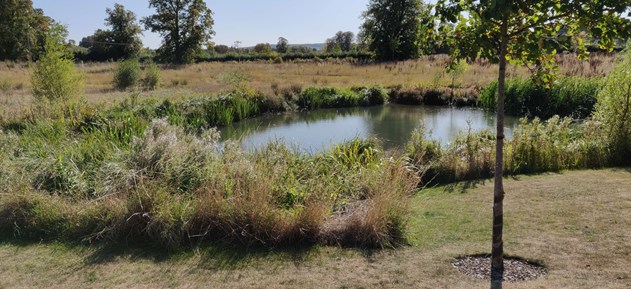 Vegetated SuDS pond in new development
Vegetated SuDS pond in new developmentWell-designed SuDS form part of the landscape, and make greener more attractive housing developments. They attract wildlife into urban areas, and create green spaces where the community can meet, exercise and play.
They reduce the risk of flooding, and filter oil and sediment to lower the quantity of pollutants which enter sewers, rivers and the sea. Where leafy or grassy SuDS are used, they can also improve air quality and help to cool temperatures in built up areas.
Here are more details about why we need SuDS in Somerset.
How SuDS work
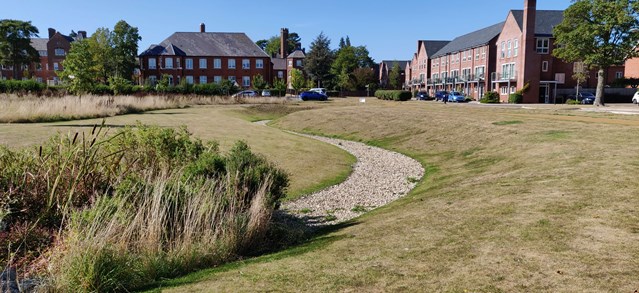 Landscaped swale and detention basin
Landscaped swale and detention basinSuDS collect rainwater where it falls, and allow the water to soak into the ground. Where it cannot soak into the ground, the water is transported close the ground surface in channels. It is then either stored in ponds and basins, or released slowly back into a river, sewer or the sea.
SuDS are designed to fill up with water during times of rain, and drain away in drier weather. They move water around the housing development close to the surface, through a network of channels and ponds.
Here are more details on how SuDS work and the sort of features you might see in Somerset.
SuDS and flood risk
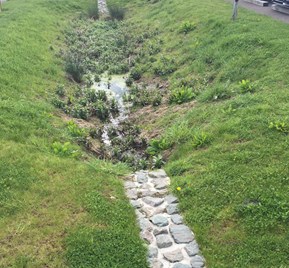 Roadside swale with erosion control
Roadside swale with erosion controlSuDS are designed to prevent flooding both on the new development and downstream. SuDS designs for major development (such as development of 10 or more homes) are reviewed by the Lead Local Flood Authority (LLFA). It will make sure that SuDS have been designed in a way that does not cause any flooding to property, through Somerset's local SuDS design standards on water quantity. It welcomes comments on planning applications relating to local flooding issues.
Somerset Council also has a SuDS Inspector, who visits developments with SuDS, to check that they have been built correctly, and are being properly maintained.
Ownership of SuDS in Somerset
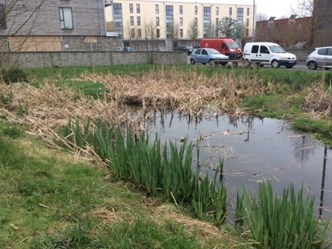 Wetland feature within new development
Wetland feature within new developmentMost of the SuDS which currently exist in Somerset are owned by the housing developers, and maintained by their management companies. If this is the case where you live, you may pay a service charge for these features to be maintained.
Where the SuDS are next to an adopted road, they may be owned and maintained by Somerset Council Highways department.
However, the rules for adoption by water companies have recently changed, and we are now likely to see more SuDS owned and maintained by water companies like Wessex Water.
Pests and insects
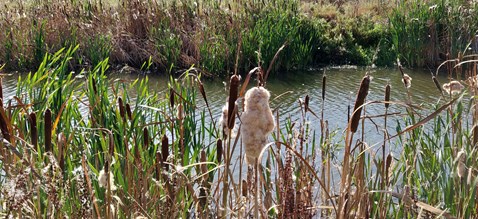 Habitat creation in new development
Habitat creation in new development
For some residents, there is a concern that SuDS components with standing water, like ponds and wetlands, attract unwanted animals and insects, such as mosquitos and rats.
However, there is no evidence that SuDS components attract more unwanted animals and insects than green spaces without SuDS. Good construction practices and regular maintenance of SuDS components helps to reduce the presence of stagnant water and litter, which can attract pests. This is supported by Somerset's local SuDS design standards for Maintenance and construction.
Maintenance of SuDS
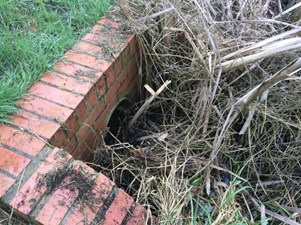 Overgrown channel at culvert outlet
Overgrown channel at culvert outletSuDS are often designed to look 'natural', to attract a range of wildlife, rather than looking like a tidy lawn. However, when SuDS components are not maintained, as in any drainage system, they can become blocked, which may lead to localised flooding.
Responsibility for maintenance of each SuDS feature should be set out during the planning process and each SuDS feature has its own required schedule of maintenance activities, as set out in Somerset's local SuDS design standards for maintenance and construction.
Collecting litter
SuDS should not collect more litter than any other open spaces, particularly if the function of the SuDS components is fully understood. A maintenance schedule should be in place, which includes regular litter picking, as set out in Somerset's local SuDS design standards for maintenance and construction.
 Linked wetland in features in a new development
Linked wetland in features in a new development SuDS and safety
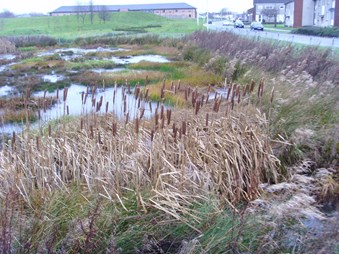 Homes overlooking a detention basin
Homes overlooking a detention basinWell-designed SuDS are safe, and Somerset's local SuDS design standards on Amenity and Health and Safety support this. The majority of SuDS components remain dry most of time, only filling up when it rains. The water which collects in SuDS should be clean, as they are designed to naturally filter out pollutants.
In SuDS components which have permanent standing water, such as ponds, water depths are kept to a minimum. They should also be designed with gently sloping sides, so people and wildlife can easily climb out if they fall in.
SuDS do not need to be fenced off, and this often prevents people from accessing and enjoying SuDS. Instead, dense planting can be used to form a barrier around open water if needed.
Who to contact?
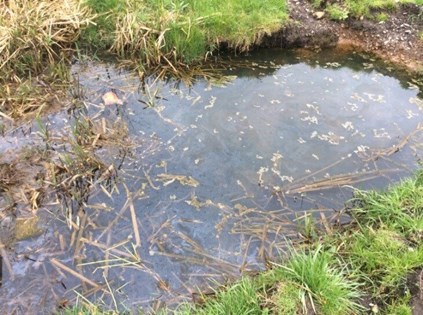 Oil pollution in a SuDS pond
Oil pollution in a SuDS pondIf you have concerns about a SuDS feature near you, contact the company responsible for its management. If you do not know who this is, Somerset Council may be able to help.
If you have concerns about underground drainage, contact Wessex Water.
If you have concerns about pollution or the water quality within SuDS components, contact the Environment Agency. Wessex Water should also be contacted (Wessex Water), if it is their adopted SuDS feature (a sign at the feature will explain whether this is the case), or if the incident involves sewage.
If you have concerns about the flood risk from a proposed development, you can comment on the planning application for the proposed site, through the relevant planning portal.
Finding out more
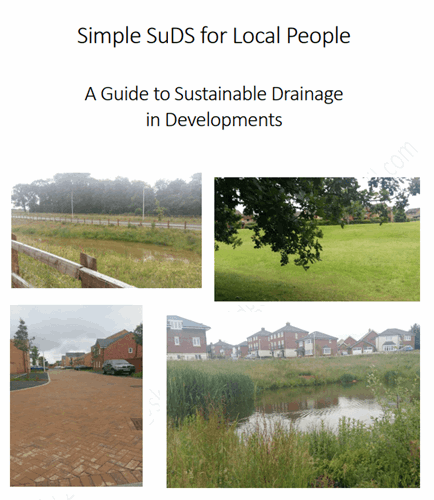 Simple SuDS for Local People
Simple SuDS for Local PeopleSimple SuDS for Local People was co-written by Teresa Bridgeman of West Somerset Flood Group. It is aimed specifically at residents and provides good examples and photographs of what SuDS should look like and how they should be maintained.

